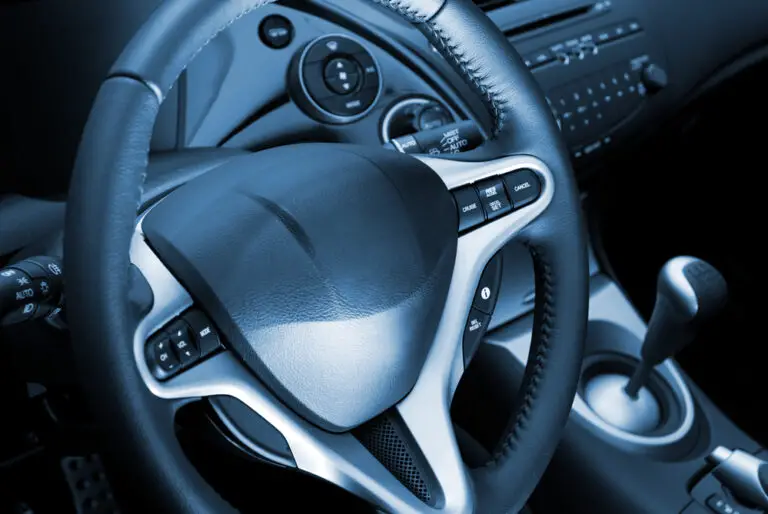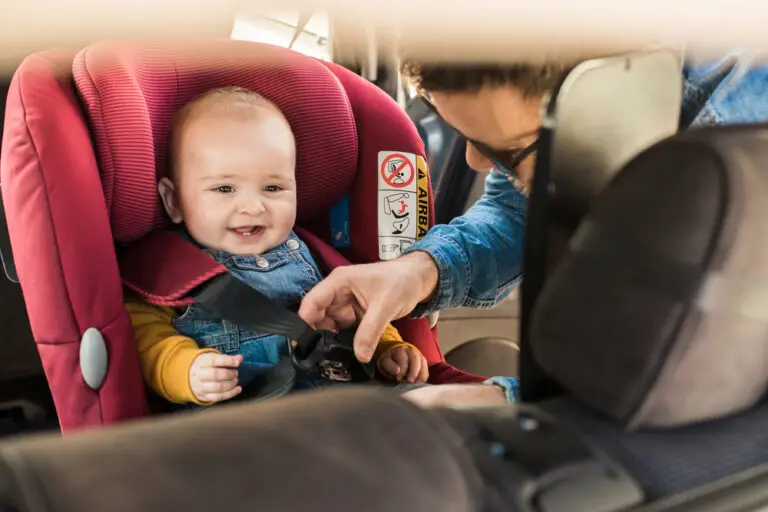Alaska Car Seat Laws 2024 (Rear, Forward & Booster)

Under the Alaska car seat laws, all children under the age of 16 years have to be secured in a federally-approved child restraint that is prescribed for their age. A violation of the law will result in a penalty.
Disclaimer: The content in this article does not constitute legal advice. It is solely for the purpose of providing information. The law is amended from time to time and the information in this article may not always be up to date. We recommend you check the original source of the law.
- AK Rear-Facing Seat Law
- AK Forward-Facing Seat Law
- AK Booster Seat Law
- AK Child Front Seat Law
- AK Child Seat Belt Law
- AK Taxi Child Seat Law
- AK Ridesharing Seat Law
- AK Child Seat Repl. Law
- Leaving Child in Car in AK
- Choosing a Child Seat in AK
- Seat Installation Help in AK
Alaska Car Seat Laws
Alaska Rear-Facing Car Seat Law
According to the rear-facing car seat law in Alaska, an infant less than one year old or who weighs less than 20 pounds (regardless of age) must be secured in a rear-facing seat. (1) This seat must meet the federal standards.
This requirement does not apply to a school bus, an emergency vehicle, a mail/newspaper delivering vehicle during working hours, and any vehicle not designed to be operated on a highway.
The rear-facing car seat age in Alaska is 1 year. But the American Academy of Pediatrics (AAP) recommends that children use a rear-facing seat for as long as possible according to the seat’s upper height or weight limits.
Violating the Alaska rear-facing child seat law carries a maximum fine of $50. You may also be assessed demerit points. (2)
Age: Newborn to 1 year
Weight: Less than 20 pounds
Penalty: Maximum $50
Alaska Forward-Facing Car Seat Law
According to the forward-facing car seat law in Alaska, children aged 1 through 4 years and weighing more than 20 pounds must be placed in a forward-facing seat. (1)
Certain vehicles are exempted, such as a school bus, emergency vehicle, a vehicle delivering mail or newspaper during its course of employment and any such vehicle not designed to run on a highway.
A driver is responsible for ensuring that the child is secured in a forward-facing seat. Disobeying the Alaska forward-facing child seat law carries a fine of up to $50 and possible demerit points. (2)
The forward-facing car seat age in Alaska is 1 to 4 years. But the National Highway Traffic Safety Administration (NHTSA) recommends keeping your child in a forward-facing seat till they reach the top height and weight limits set by the car seat manufacturer.
Age: 1 to 4 years
Weight: 20+ pounds
Penalty: Maximum $50
Alaska Booster Seat Law
According to the child booster seat law in Alaska, children above 4 years but less than 8 years of age who are shorter than 57 inches and weigh between 20 to 65 pounds must be secured in a booster seat. (1)
Those children who are older than 4 years and exceed these height or weight requirements can use a seat belt. Similarly, those above 8 years but less than 16 years of age who do not exceed the above requirements may use a booster seat or the seatbelt as determined by the driver.
The booster seat age in Alaska is dependent on the requirements of the child. It ranges from 4 to 15 years. Based on your child’s situation, you can use a high-back or backless booster seat.
Violating the Alaska booster seat requirements will get you a fine of a maximum $50. (2)
Age: 4 to 15 years
Height: Shorter than 57”
Weight: 20 to 65 pounds
Penalty: Maximum $50
Alaska Child Front Seat Law
There is no express child front seat law in Alaska. However, the AAP recommends for children to sit in the backseat till they are 13 years old. This is because the rear seat is the safest for kids.
But if unavoidable, the child can ride in the front seat. They must be placed in a child restraint that is appropriate for their height and weight. The front seat airbag must be deactivated. Any violation of these laws will attract a penalty of up to $50. (2)
Though the front seat age in Alaska is unclear, a child older than 4 years, taller than 57 inches and weighing more than 65 pounds can wear a regular seat belt. (1) Hence, if the child meets these requirements, they can sit in the front seat with a seat belt.
Penalty: Maximum $50
Alaska Child Seat Belt Law
According to the child seat belt law in Alaska, a child above 4 years of age, taller than 57 inches, and weighing more than 65 pounds can wear an adult safety belt. Those who do not exceed these height and weight requirements can wear a seatbelt in a booster seat. (1)
Under the Alaska children’s seat belt law, all children above 4 years and less than 18 years of age must wear a seat belt (including in a booster seat). This holds true if they are riding in the front seat or the backseat. These do not apply to a school bus or a vehicle without seat belts.
The seat belt rules in Alaska are strictly enforced. For children older than 16 years. not wearing a seat belt carries a fine of $15. For those between 4 to 16 years of age, the fine can go up to $50. (2)
Age: Above 4 years
Height: 57” or taller
Weight: 65+ pounds
Penalty: $15 for children above 16 years; maximum $50 for others
Alaska Taxi Child Seat Law
According to the taxi child seat law in Alaska, taxis are also required to have appropriate child restraints. Every child passenger under the age of 16 years must be secured in a federally-approved child safety seat or seat belt.
The only vehicles exempt are a school bus, an emergency vehicle, a mail/newspaper delivering vehicle during working hours, and any vehicle not designed to be operated on a highway. (1)
Under Alaska child seat laws, the driver is responsible to provide a taxi child seat in Alaska. However, they may not have the best-suited car seat for your child. Hence, it is recommended that you take your own child seat and install it securely in the taxi.
Disobeying the law carries a penalty of a maximum of $50. (2)
Alaska Ridesharing Child Seat Law
The ridesharing child seat law in Alaska is unclear. The Alaska car seat regulations do not expressly mention ridesharing services. They mandate a proper child safety restraint for children under 16 years of age. But they do not state if these requirements apply to ridesharing companies such as Uber and Lyft. (1)
In the absence of an express requirement, we recommend that caregivers place their children in an appropriate child seat when traveling in a rideshare vehicle. You can refer to the NHTSA recommendations while choosing a car seat for your child.
The driver can also have an all-in-one seat that can change from a rear-facing to a forward-facing seat with a harness and also a booster seat. This may be one the best child passenger safety seats in Alaska for drivers.
A violation of the law will get the driver a fine of up to $50.(2)
Alaska Child Seat Replacement Law
There is no specific child seat replacement law in Alaska. However, it is important to replace the car seat if it is damaged or expired.
The NHTSA recommends replacing the seat if your vehicle is involved in a moderate or severe accident in Alaska. The seat may have suffered damage that is not visible to the naked eye. Therefore, child seat replacement after an accident is extremely important.
The NHTSA does not recommend immediately replacing the car seat after a low-impact accident. In this type of crash, the severity of damage is low.
The passengers are not injured, the vehicle can be driven away from the accident site, the door nearest to the child safety seat and the seat itself is not damaged.
You should also replace the car seat if it has expired as per the manufacturer’s information.
Leaving Child in The Car in Alaska
There is no express law on leaving a child in a vehicle in Alaska. However, it is dangerous to leave a child unattended in the vehicle. Temperatures inside the vehicle can rise drastically within minutes.
This puts the child at grave danger of suffering a heat stroke. Their body temperature rises faster than adults. Consequently, they can suffer serious injury in only a few minutes.
Even though leaving a child in the car in Alaska is not illegal, the Office of Children’s Services warns against leaving a child unsupervised. Inadequate supervision can result in charge of neglect in court.
There are other serious consequences of leaving a child unattended in a vehicle. They may suffer dehydration, an in-car accident, be kidnapped or get strangled by the power windows or the seat belt.
Choosing a Child Car Seat in Alaska
When choosing a car seat in Alaska, ensure that it complies with Alaska state law. The best approach is to follow the NHTSA recommendations. For children younger than 1 year or weighing less than 20 pounds, a rear-facing seat is the best car seat to use in Alaska. For children aged 1 through 4 years who weigh more than 20 pounds, you should use a forward-facing car seat.
If your child is between 4 to 16 years of age, shorter than 57 inches and weighs less than 65 pounds, they should ride in a booster seat. The best booster seat to use in Alaska is the one that allows the seat belt to fit firmly across your child’s shoulders and lap.
Car Seat Installation Help in Alaska
Installing a car seat can be a complex task if you have not done it before. The seat has to be securely installed in your vehicle. For this, you need to read through the manuals of the car seat and your vehicle. T
o help you with safe installation, there are certified Child Passenger Safety (CPS) technicians. They can also inspect your seats and are available at designated stations. Some of these are:
- Center for Safe Alaskans
- Juneau Police Department
- The City of Ketchikan Fire Department
- Fairbanks Safe Rider Program
- Eielson Air Force Base
- Native Village of Eyak
You can find other locations on the Alaska Child Passenger Safety Coalition website.
Alaska Car Seat Safety Resources
Some of the resources that you can refer to learn about child seat requirements in Alaska are:
- Occupant Protection Program, Alaska Highway Safety Office: A program of the Alaska Department of Transportation and Public Facilities, it provides information, data, and resources on child passenger safety.
- Fairbanks Safe Rider Program: It is a part of Safe Kids Fairbanks and provides education on car seats, booster seats, and vehicle safety.
- Center for Safe Alaskans: Previously known as the Alaska Injury Prevention Center, it adopts a public health approach to identify trends using data and implement injury prevention programs.
- Safe Kids Alaska: Led by Providence Alaska Medical Center, it conducts car seat checks and safety workshops.
FAQ
How long should a child ride in a rear-facing car seat in Alaska?
Under the car seat laws in Alaska, a child should ride in a rear-facing seat till they are 1 year old or weigh less than 20 pounds.
Can you put a rear-facing car seat in the front seat in Alaska?
There is no law in Alaska that prevents you from putting a rear-facing seat in the front seat. But you must deactivate the front seat airbag.
Can you put a rear-facing car seat in the middle rear seat in Alaska?
You can put a rear-facing car seat in the middle rear seat if your vehicle has lower anchors for proper installation of the car seat.
When can a baby face forward in a car seat in Alaska?
A baby can ride in a forward-facing car seat in Alaska when they are between 1 to 4 years old and weigh at least 20 pounds.
How old for a booster seat in Alaska?
A child who is between 4 to 8 years old, shorter than 57 inches and weighs between 20 to 65 pounds can ride in a booster seat in Alaska.
When to use a backless booster seat in Alaska?
You can use a backless booster seat only if your vehicle seat has a head rest and the child’s ears are not higher than the seat back.
When can a child sit in the front seat in Alaska?
There is nothing mentioned in the law. The AAP recommends that children sit in the front seat after they turn 13 years old. Until then, they should ride in the backseat.
When can a child sit in the front seat with a booster in Alaska?
The child can sit in the front seat with a booster but the seat should be pushed as far from the dashboard as possible. The front seat airbag must be deactivated.
When can a child stop using a booster seat in Alaska?
A child can stop using a booster seat once they are at least 57 inches tall and weigh at least 65 pounds. There is no specific age.
When to switch from 5 point harness to a seat belt in Alaska?
When the child outgrows the height and weight limits of the 5-point harness of a forward-facing seat, they can switch to wearing a seat belt in a booster seat.
When can a child use a regular seat belt in Alaska?
A child older than 4 years can use a regular seat belt if they are taller than 57 inches and weigh more than 65 pounds.
Do you need a car seat in a taxi in Alaska?
Yes, you need a car seat in a taxi in Alaska. The driver will be responsible for providing an appropriate child passenger safety seat that meets federal standards.
Do you need a car seat in an Uber in Alaska?
The law is unclear on this issue. But either the caregiver or the driver should provide an appropriate car seat to ensure the child’s safety.
Do you need a car seat in a Lyft in Alaska?
The law is not clear. But either the caregiver or the driver should provide a federally approved and appropriate car seat to ensure the child’s safety.

Rishima Rawat
Rishima Rawat is a lawyer and legal writer with over six years of writing and legal experience. She earned her LLB degree from the West Bengal National University of Juridical Sciences, Kolkata. With a passion for child safety, she’s written extensively about the U.S. car seat laws in ParentingMode. She collaborates with businesses and law firms globally, enhancing their online content. Her insights are also published in legal journals like RGNUL, NLIU, and RMLNLU Law Review. Committed to the cause of education, she has volunteered with IDIA, which helps underprivileged children in India to access legal education. She has also worked with Enhelion Knowledge Ventures, a leading legal ed-tech platform in India that provides students with affordable courses in law. Fluent in English and Hindi with elementary proficiency in Spanish, Rishima combines her legal expertise with a dedication to child safety.






